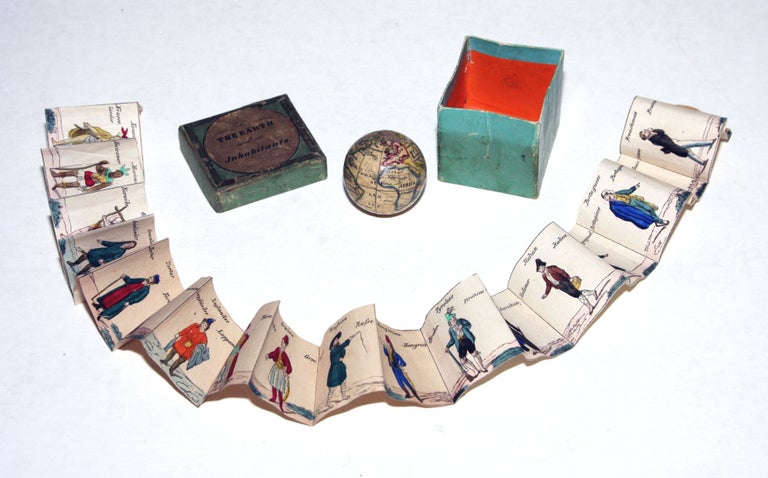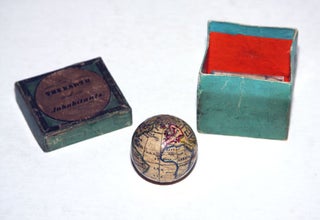The Earth and Its Inhabitants.
Globe 1 ¾ inches diameter; box 2 ½ x 2 ¼ x 2 ¼ inches; print 2 x 42 inches. Original hand color; globe in excellent condition overall with light toning & wear; box good with mended separation at one corner; foldout engraving excellent, formerly attached to inside of box.
A delightful miniature globe, the smallest we have handled, complete with its original box and a fold-out engraving illustrating the peoples of the world in their traditional costumes. Its author is not named, but the work has been attributed to C. J. S. Bauer, a Nuremberg globemaker, who produced material for the English market. Throughout the Georgian and the Victorian eras, England was firmly established as a global power – one the first nations that could stake that claim. Consequently, the English maintained a keen interest in the variety of nations and cultures they encountered in the exercise of power. The globe – like most pocket globes – served a combination of purposes, primarily novelty and education. But to a certain extent, such baubles were an expression of the English fascination with the extent of their empire. The size of the globe, naturally, dictated a certain superficiality of detail: the continents are named, but few countries are. A handful of cities are named, but not all are precisely located; London, Paris, Madrid and Constantinople appear to be in largely the correct place, although Jerusalem appears in the general vicinity of Baghdad.
The charming fold-out print supplements the globe by presenting a glimpse of both the civilized and the “savage” people to be found around the world. The printed, accordion-folded strip was attached to the base of the box, which meant that its subjects were shown in a specific order: first, an Englishman and a Frenchman, in urbane modern dress, followed by more traditionally and primitively dressed figures. Most are European; the only Asian people shown are a Tatar, a Turk, and the obscure Kalmyks. There are no Africans at all. The more exotic cultures shown belong to the Americas and the Pacific: a Greenlander, an Iroquois, a Caribe warrior, an Eskimo, a Mexican, a Peruvian, a New Zealander and a Hawaiian.
Sold


